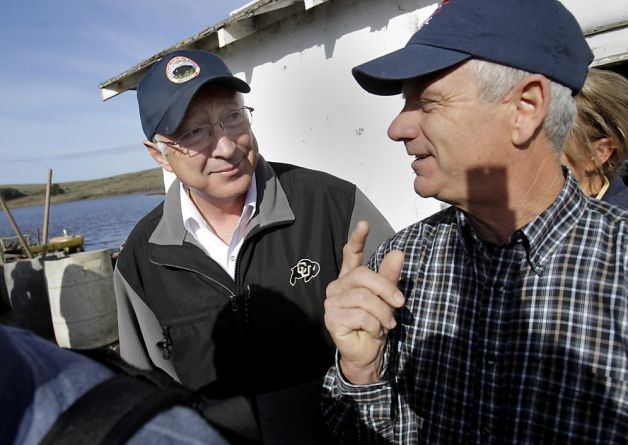Posted on SFGate: 21 Nov 2012 — By Peter Fimrite
Interior Secretary Ken Salazar (left) tours Drakes Bay Oyster Co. with its owner, Kevin Lunny. The lease will expire at the end of the month. Photo: Brant Ward, The Chronicle / SF
U.S. Interior Secretary Ken Salazar toured a popular oyster farm at Point Reyes National Seashore on Wednesday that Park Service officials are trying to evict, saying he wanted a look at the operation before deciding whether it should stay.
The visit comes amid a legal and philosophical slugfest over the fate of the shellfish operation on picturesque Drakes Bay.
Salazar said he will make a decision next week on whether to extend Drakes Bay Oyster Co.‘s lease for 10 years, which would effectively prevent the National Park Service from turning the estuary into a marine wilderness. The option to extend the lease is on his desk largely because of Sen. Dianne Feinstein‘s criticism of what she and others have said was the Park Service’s unfair and, in some cases, dishonest attempts to kick the oyster farm out.
Feinstein, D-Calif., included a rider in an appropriations bill that gave Salazar discretion to extend the oyster purveyor’s lease or terminate it when it expires Nov. 30.
‘Important decision’
“I would not be here if this wasn’t an extremely important decision,” said Salazar, adding that the preservation of farms and agriculture is a key issue for him. “I appreciate the contribution in this county that agriculture makes.”
Kevin Lunny, who bought the shellfish operation from Johnson Oyster Co. in 2004, is allowed to harvest oysters in Drakes Bay under a 40-year occupancy agreement reached in 1972. The estuary is supposed to become a marine wilderness area after the lease expires, but Lunny is asking Salazar to allow him to continue selling shellfish.
Supporters of Lunny, including Marin County Supervisor Steve Kinsey and former Peninsula Rep. Pete McCloskey, sat down with Salazar Wednesday and urged him to support Lunny.
“We believe there is an opportunity to protect the environment, to uphold the values of the National Park Service, and to maintain this working landscape,” Kinsey said.
After touring the operation, Salazar met with representatives of some of the 16 environmental organizations that want to see the nonnative Japanese oysters removed from Drakes Bay and the waterway returned to wilderness. They include the Sierra Club, Natural Resources Defense Council, the Wilderness Society and the Marin Audubon Society.
“The public has been waiting for more than three decades for this agreement to be fulfilled,” said Neal Desai, associate director for the National Parks Conservation Association, adding that there are many other places where oysters can be grown. “This is our one opportunity to create a marine wilderness on the West Coast.”
The issue is huge in rural west Marin County, where many consider the oysters from Drakes Bay a delicacy.
Sharing land
The vast coastal area is a haven for cattle ranchers, sheepherders and organic farmers who live and work next to, and in some cases on, National Park Service land. It is a unique relationship, forged years ago in the fight to preserve the land from development.
Park Service officials have long contended that the oyster operation harms the environment. Their draft environmental impact statement in 2011 concluded that the oyster farm has a major impact on the Drakes Bay “soundscape” and has moderate impacts on wetlands, eelgrass, fauna, harbor seals, birds and the coastal flood zone.
The impacts, officials said, are so great that the oyster company lease should be terminated.
But the Park Service review has itself come under scrutiny. In August, the National Academy of Sciences concluded that there was not enough information in the review to determine whether the oyster operation was harming the historic waterway. The academy’s National Research Council said, in essence, that the scientific evidence did not support claims that the shellfish operation caused noise pollution, scared birds and harbor seals or harmed shoreline habitat.
Credibility questioned
The academy report represented another blow to the park service, which has been accused by oyster farm proponents of a pattern of misconduct, including the deliberate fudging of data.
In 2009, a panel of scientists concluded that park officials had made errors, selectively presented information and misrepresented facts in a series of reports about the shellfish operation.
No misconduct
Last year, the Interior Department‘s office of the solicitor released a report outlining what it termed biased, improper, mistake-ridden work by park scientists, but cleared the researchers of misconduct.
The park’s environmental review was required by Feinstein, who was dismayed by the various negative reports and has been highly critical of the science used by the Park Service.
Peter Fimrite is a San Francisco Chronicle staff writer.
E-mail: pfimrite@sfchronicle.com Twitter: @pfimrite
